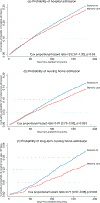Memory care reduces nursing home admissions among assisted-living residents with dementia
- PMID: 34978132
- PMCID: PMC9250544
- DOI: 10.1002/alz.12513
Memory care reduces nursing home admissions among assisted-living residents with dementia
Abstract
Introduction: We compare nursing-home and hospital admissions among residents with Alzheimer's disease and related dementias (ADRD) in memory-care assisted living to those in general assisted living.
Methods: Retrospective study of Medicare beneficiaries with ADRD in large (>25 bed) assisted-living communities. We compared admission to a hospital, to a nursing home, and long-term (>90 day) admission to a nursing home between the two groups, using risk differences and survival analysis.
Results: Residents in memory-care assisted living had a lower adjusted risk of hospitalization (risk difference = -1.8 percentage points [P = .014], hazard ratio = 0.93 [0.87-1.00]), a lower risk of nursing-home admission (risk difference = -2.2 percentage points [P < .001], hazard ratio = 0.87 [-.79-0.95]), and a lower risk of a long-term nursing home admission (risk difference = -1.1 percentage points [P < .001], hazard ratio = 0.71 [0.57-0.88]).
Discussion: Memory care is associated with reduced rates of nursing-home placement, particularly long-term stays, compared to general assisted living.
Keywords: Alzheimer's disease and related dementias; assisted living; dementia care; hospitalization; memory care; nursing home admission; residential care.
© 2021 the Alzheimer's Association.
Conflict of interest statement
CONFLICTS OF INTEREST
The authors have no financial conflicts of interest to report.
Figures


References
-
- Harris-Kojetin LD, Sengupta M, Lendon JP, Rome V, Valverde R, Caffrey C. Long-term care providers and services users in the United States, 2015–2016. Vital Health Stat. 2019;3(43). Feb. DHHS Publication No. 2019–1427, p. 18, Fig. 19. - PubMed
-
- Zimmerman S, Sloane PD, Reed D. Dementia prevalence and care in assisted living. Health Aff. 2014;33(4):658–666. Apr 1. - PubMed
-
- Carder PC. State regulatory approaches for dementia care in residential care and assisted living. Gerontologist. 2017;57(4):776–786. - PubMed
Publication types
MeSH terms
Grants and funding
LinkOut - more resources
Full Text Sources
Medical

